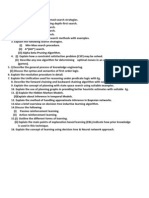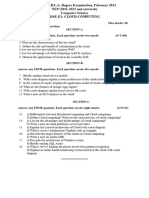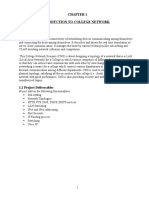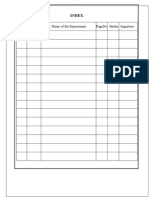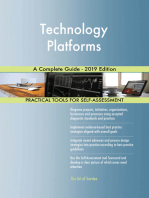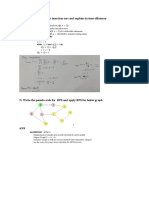0%(1)0% found this document useful (1 vote)
310 viewsAssignment Questions For Os
Assignment Questions For Os
Uploaded by
Varun. B. CThis document contains 19 questions about operating system concepts for an assignment. The questions cover topics such as process states, virtual machines, layered OS structure, dual mode operation, multiprocessing and clustering, client-server vs peer-to-peer computing, single and multi-processor systems, OS services, multicore programming, multiprogramming, traditional computing models, system calls, scheduling, context switching, message passing, computer system organization, abstract system components, interprocess communication models, and OS operations.
Copyright:
© All Rights Reserved
Available Formats
Download as DOCX, PDF, TXT or read online from Scribd
Assignment Questions For Os
Assignment Questions For Os
Uploaded by
Varun. B. C0%(1)0% found this document useful (1 vote)
310 views1 pageThis document contains 19 questions about operating system concepts for an assignment. The questions cover topics such as process states, virtual machines, layered OS structure, dual mode operation, multiprocessing and clustering, client-server vs peer-to-peer computing, single and multi-processor systems, OS services, multicore programming, multiprogramming, traditional computing models, system calls, scheduling, context switching, message passing, computer system organization, abstract system components, interprocess communication models, and OS operations.
Original Title
ASSIGNMENT QUESTIONS FOR OS
Copyright
© © All Rights Reserved
Available Formats
DOCX, PDF, TXT or read online from Scribd
Share this document
Did you find this document useful?
Is this content inappropriate?
This document contains 19 questions about operating system concepts for an assignment. The questions cover topics such as process states, virtual machines, layered OS structure, dual mode operation, multiprocessing and clustering, client-server vs peer-to-peer computing, single and multi-processor systems, OS services, multicore programming, multiprogramming, traditional computing models, system calls, scheduling, context switching, message passing, computer system organization, abstract system components, interprocess communication models, and OS operations.
Copyright:
© All Rights Reserved
Available Formats
Download as DOCX, PDF, TXT or read online from Scribd
Download as docx, pdf, or txt
0%(1)0% found this document useful (1 vote)
310 views1 pageAssignment Questions For Os
Assignment Questions For Os
Uploaded by
Varun. B. CThis document contains 19 questions about operating system concepts for an assignment. The questions cover topics such as process states, virtual machines, layered OS structure, dual mode operation, multiprocessing and clustering, client-server vs peer-to-peer computing, single and multi-processor systems, OS services, multicore programming, multiprogramming, traditional computing models, system calls, scheduling, context switching, message passing, computer system organization, abstract system components, interprocess communication models, and OS operations.
Copyright:
© All Rights Reserved
Available Formats
Download as DOCX, PDF, TXT or read online from Scribd
Download as docx, pdf, or txt
You are on page 1of 1
ASSIGNMENT QUESTIONS FOR OS
1. Explain the process states with a neat diagram .
2. With a neat diagram explain the concept of virtual machine.
3. Explain layered approach structure of operating system with diagram.
4. Explain dual mode operation of an operating system.
5. Explain the types of multiprocessing and types of clustering.
6. Differentiate between client server computing and peer to peer computing.
7. Illustrate with a neat diagram single ,multi processor systems in computer
system architecture .
8. Explain operating system services with respect to user and system with
figure.
9. Explain multicore programming ,With present challenges in programming.
10. Explain the benefits of multiprogramming .
11. Explain traditional computing .Compare client server computing with peer
to peer computing .
12. Define operating system.Explain briefly multiprocessing system and time
sharing system.
13. What are system calls? Briefly explain types of system call.
14. Explain scheduler in a process execution . Explain the concept of context
switching.
15. Explain direct and indirect communication with respect to message passing
system.
16. Explain about computer system organization with neat diagram.
17. Explain in detail about the abstract view of the components of the computer
system with a neat diagram.
18. Define interprocess communication.Explain the two models of IPC using a
diagram.
19. Explain operations on a operating system in detail.
You might also like
- CSE16 Operating Systems Practice Subjective Questions For ETEDocument9 pagesCSE16 Operating Systems Practice Subjective Questions For ETEHritik RajNo ratings yet
- Vu Re Lecture 13Document23 pagesVu Re Lecture 13Umair KhanNo ratings yet
- Vu Re Lecture 16Document28 pagesVu Re Lecture 16ubaid ullahNo ratings yet
- Ambo University Woliso CampusDocument10 pagesAmbo University Woliso CampusTolosa TafeseNo ratings yet
- Cloud Computing All Unit NotesDocument53 pagesCloud Computing All Unit NotesKritik BansalNo ratings yet
- CS3451 OS UNIT 1 NOTES EduEnggDocument34 pagesCS3451 OS UNIT 1 NOTES EduEnggDilip RavikumarNo ratings yet
- 15cs81-Iot SyllabusDocument3 pages15cs81-Iot SyllabusAnu CadzieNo ratings yet
- SPM OldqnpapersDocument6 pagesSPM OldqnpapersSurìyáNo ratings yet
- CS3451-OS Syllabus 2021Document1 pageCS3451-OS Syllabus 2021Karthick MNo ratings yet
- Mc5024-Web Design ModelDocument2 pagesMc5024-Web Design ModelMsec McaNo ratings yet
- Virtualization For Data-Center AutomationDocument3 pagesVirtualization For Data-Center Automationupkar computerNo ratings yet
- Ad SW Final Revision Essay QuestionDocument4 pagesAd SW Final Revision Essay QuestionKAREEM Abo ELsouDNo ratings yet
- Computer Graphics Question BankDocument7 pagesComputer Graphics Question Bankniranjani0408No ratings yet
- BCA & BSC (CS) SylDocument93 pagesBCA & BSC (CS) Sylgladraj_22No ratings yet
- Cs2351 Artificial Intelligence 16 MarksDocument1 pageCs2351 Artificial Intelligence 16 MarksSiva Kumar100% (1)
- Question Bank Computer Networks UnitVDocument2 pagesQuestion Bank Computer Networks UnitVBrijesh Yadav100% (1)
- SE4151 NotesDocument113 pagesSE4151 NotesraviNo ratings yet
- Chapter Eight: Building The E-Business Backbone: Enterprise Resource PlanningDocument22 pagesChapter Eight: Building The E-Business Backbone: Enterprise Resource PlanningAdarsh NairNo ratings yet
- Cloud Computing Question PaperDocument1 pageCloud Computing Question PapermamathamNo ratings yet
- Cloud Computing LAB ManualDocument13 pagesCloud Computing LAB ManualBhargav RajyagorNo ratings yet
- EC2303 Computer Architecture and Organization QUESTION PAPERDocument4 pagesEC2303 Computer Architecture and Organization QUESTION PAPERJayagopal JaiNo ratings yet
- CS2302 Computer Networks Anna University Engineering Question Bank 4 UDocument48 pagesCS2302 Computer Networks Anna University Engineering Question Bank 4 UkuttymythuNo ratings yet
- CS8079 - Hci QB Unit1Document19 pagesCS8079 - Hci QB Unit1Ramesh Kumar100% (2)
- Unit 1 - CD Cs3501Document24 pagesUnit 1 - CD Cs3501harishkarnan004No ratings yet
- It8075 SPM Unit IIIDocument101 pagesIt8075 SPM Unit IIILionel Bharath RazerNo ratings yet
- Cs3591 CN Unit 5 NotesDocument27 pagesCs3591 CN Unit 5 Notesramyadevi100% (1)
- 5153 DESIGN and ANALYSIS of ALGORITHMS Anna University Previous Year Question PaperDocument6 pages5153 DESIGN and ANALYSIS of ALGORITHMS Anna University Previous Year Question Paperarumugam1984293269100% (1)
- CS1403 CASE Tools Lab ManualDocument67 pagesCS1403 CASE Tools Lab Manualrajaluckmi100% (2)
- Cs9251 Mobile Computing Question BankDocument16 pagesCs9251 Mobile Computing Question BankNivitha100% (1)
- EC 8791 ERTS 2 MarksDocument24 pagesEC 8791 ERTS 2 Marksdeenandhini b100% (2)
- Case Study of Various Routing AlgorithmDocument25 pagesCase Study of Various Routing AlgorithmVijendra SolankiNo ratings yet
- Anna University Engineering Question BankDocument7 pagesAnna University Engineering Question BankJanaki JanNo ratings yet
- CC QTN PaperDocument2 pagesCC QTN Paperbalaanand_mcaNo ratings yet
- Ex. No: 1 Date: GUI Components, Font and Colours AimDocument10 pagesEx. No: 1 Date: GUI Components, Font and Colours AimindhuNo ratings yet
- Software Engineering Question BankDocument1 pageSoftware Engineering Question Bankajaykumar988No ratings yet
- Assignment Hci PDFDocument1 pageAssignment Hci PDFPriyanka Pal0% (1)
- Software Project Management: Nehru Institute of Engineering and TechnologyDocument39 pagesSoftware Project Management: Nehru Institute of Engineering and TechnologysakthisubiNo ratings yet
- STM Viva QueDocument54 pagesSTM Viva Quearellasaikiran100% (2)
- Bidtk258 Idt QuizDocument9 pagesBidtk258 Idt QuizAppaji Reddy. VNo ratings yet
- Ccs341 DW Lab Manual Chumma Chumma Practical NotesDocument89 pagesCcs341 DW Lab Manual Chumma Chumma Practical Notesmnishanth2184No ratings yet
- Project Report 1Document46 pagesProject Report 1archit garg100% (1)
- Attendance Management Using AWS Cloud: AbstractDocument7 pagesAttendance Management Using AWS Cloud: AbstractBeckyNo ratings yet
- ccs341 Data Warehousing Lab Manual2021Document41 pagesccs341 Data Warehousing Lab Manual2021BhuvaneshNo ratings yet
- COCOMO II A Parametric Productivity Model: Software Project Management (KOE-068)Document2 pagesCOCOMO II A Parametric Productivity Model: Software Project Management (KOE-068)pemom29928No ratings yet
- RPA Unit 4 DCDocument34 pagesRPA Unit 4 DCyogesh nikamNo ratings yet
- Chapter 3 Cloud ApplicationsDocument15 pagesChapter 3 Cloud ApplicationsBrainy B. BrainNo ratings yet
- SeminarDocument20 pagesSeminarAbhishek Agarwal100% (2)
- SPM 2 Marks Q&aDocument12 pagesSPM 2 Marks Q&aJulie Emerald JijuNo ratings yet
- Requirement Analysis and SpecificationDocument8 pagesRequirement Analysis and SpecificationSuvendu DeyNo ratings yet
- IT-413 System and Network AdministrationDocument3 pagesIT-413 System and Network AdministrationMuhammad Aziz UllahNo ratings yet
- Network Management System A Complete Guide - 2020 EditionFrom EverandNetwork Management System A Complete Guide - 2020 EditionRating: 5 out of 5 stars5/5 (1)
- Question Bank Os - Ia1Document2 pagesQuestion Bank Os - Ia1KAVYA SHREENo ratings yet
- 1st IA QB OSDocument3 pages1st IA QB OSKartik KumarNo ratings yet
- Question Bank For Unit Test #1Document2 pagesQuestion Bank For Unit Test #1Nikita PatilNo ratings yet
- DSDocument9 pagesDSJayant KodamNo ratings yet
- Unit 1: Introduction To Operating System Structure: ComputingDocument2 pagesUnit 1: Introduction To Operating System Structure: ComputingShobha KumarNo ratings yet
- Oomd Mod4Document48 pagesOomd Mod4Varun. B. CNo ratings yet
- Oomd Mod3Document22 pagesOomd Mod3Varun. B. CNo ratings yet
- Module 1Document11 pagesModule 1Varun. B. CNo ratings yet
- Daa Assignment (2) SolutionDocument13 pagesDaa Assignment (2) SolutionVarun. B. CNo ratings yet















